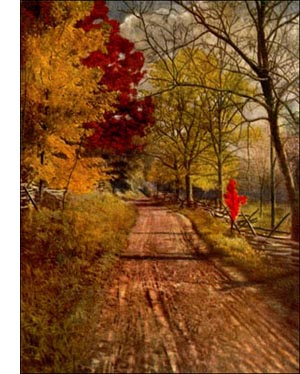Magnolia or Great Laurel Magnolia Tree
 Magnolia, Great Laurel Magnolia (Magnolia faetida, Sarg.) -A regular, conical tree, 50 to 80 feet high; trunk 2 to 4 feet in diameter; branches, strict, ascending. Bark thin, scaly, light brown or grey; on branches, smooth, pale grey. Wood hard, close grained, heavy, cream coloured turning to brown. Buds rusty pubescent, scaly; terminal, 1 to 1 1/2 inches long. Leaves alternate, oval, 5 to 8 inches long, leathery, shining above, lined with rusty down, or smooth and dull green ; persistent until second spring. Flowers, April to August; white, cup shaped, 6 to 8 inches across when spread; fragrant; solitary on end of twig; sepals three, petal-like; petals thick, waxen, 6 to 9; stamens, many, purple at base; pistils, many, crowded. Fruit, a rusty brown, oval cone, 3 to 4 inches long, pubescent; seeds flat, red, two in each cell, hung out on threads; ripe in November. Preferred habitat, rich, moist soil; swamp borders or river banks; sometimes on uplands. Distribution, North Carolina coast to Florida (Mosquito Inlet and Tampa Bay), west along Gulf coast to Brazos River Valley in Texas; north along Mississippi bluffs and bayous into northern Louisiana and southern Arkansas. Uses: Superb ornamental tree, hardy to Philadelphia. Branches cut for Christmas decorations. Wood used for fuel.
Magnolia, Great Laurel Magnolia (Magnolia faetida, Sarg.) -A regular, conical tree, 50 to 80 feet high; trunk 2 to 4 feet in diameter; branches, strict, ascending. Bark thin, scaly, light brown or grey; on branches, smooth, pale grey. Wood hard, close grained, heavy, cream coloured turning to brown. Buds rusty pubescent, scaly; terminal, 1 to 1 1/2 inches long. Leaves alternate, oval, 5 to 8 inches long, leathery, shining above, lined with rusty down, or smooth and dull green ; persistent until second spring. Flowers, April to August; white, cup shaped, 6 to 8 inches across when spread; fragrant; solitary on end of twig; sepals three, petal-like; petals thick, waxen, 6 to 9; stamens, many, purple at base; pistils, many, crowded. Fruit, a rusty brown, oval cone, 3 to 4 inches long, pubescent; seeds flat, red, two in each cell, hung out on threads; ripe in November. Preferred habitat, rich, moist soil; swamp borders or river banks; sometimes on uplands. Distribution, North Carolina coast to Florida (Mosquito Inlet and Tampa Bay), west along Gulf coast to Brazos River Valley in Texas; north along Mississippi bluffs and bayous into northern Louisiana and southern Arkansas. Uses: Superb ornamental tree, hardy to Philadelphia. Branches cut for Christmas decorations. Wood used for fuel.The magnolia that Linnaeus named grandi flora is a kingly tree. It is not graceful, for its limbs are stiffly erect. Even the twigs and leaves are stiff, and in blossom the tree is like a great system of candelabra, each terminal bud containing a single flower. But look at a fine specimen tree as it stands in a Southern garden new-washed by a night rain. Each leaf of the dark pyramid of green reflects the sunlight like a blade of polished metal. This lustrous foliage mass is just the foil to set off the purity of the white flowers. Each is like a great camellia, or a water lily, with waxen petals, enclosing the purple heart. William Bartram likened them to great white roses, and declared that he could see them distinctly a mile away. The blossoms, when fully open, are from 7 to 8 inches across, as a rule. There is a horticultural variety called gloriosa, the flowers of which Mr. Berckmanns says are 14 inches in diameter. In southern California there are double and ever-blooming varieties exploited by nurserymen, and there are no more popular ornamental trees than these. Unfortunately, this magnolia has one drawback-its flowers have a heavy odour which is disagreeable to many people. Another is this: They cannot be shipped as cut flowers, for the slightest bruise of the waxy petals produces a brownish discolouration. This is the species that furnishes the splendid evergreen foliage that is shipped North for Christmas decoration, and is used for similar purposes in the South. The upper surface of each leaf is a dark, lustrous green; the lining of rusty-red fuzz is shed when the leaf is old. Negroes go into the woods and cut down large trees and small to strip them of their leafy branches.
The comparative uselessness of its wood has until now been the saving of the species. This new industry already threatens its extermination in many sections of the South.
In cultivation this magnolia is oftenest seen as a small tree, from 20 to 50 feet high, planted on lawns and in parks or lining avenues. In the forests of Louisiana, where it reaches its greatest perfection, it stands 80 feet high, with a trunk 4 feet thick. Professor Sargent calls it "the most splendid ornamental tree in the American forests."